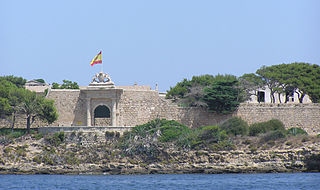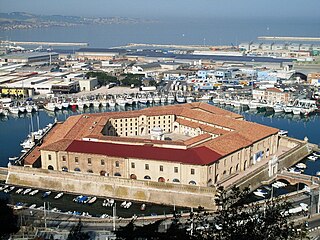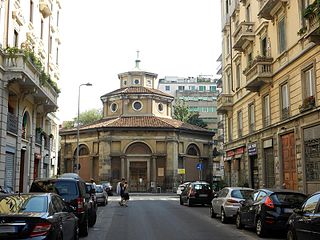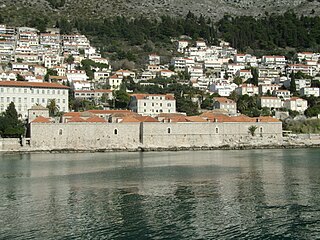
A quarantine is a restriction on the movement of people, animals and goods which is intended to prevent the spread of disease or pests. It is often used in connection to disease and illness, preventing the movement of those who may have been exposed to a communicable disease, yet do not have a confirmed medical diagnosis. It is distinct from medical isolation, in which those confirmed to be infected with a communicable disease are isolated from the healthy population. Quarantine considerations are often one aspect of border control.

A leper colony, also known by many other names, is an isolated community for the quarantining and treatment of lepers, people suffering from leprosy. M. leprae, the bacterium responsible for leprosy, is believed to have spread from East Africa through the Middle East, Europe, and Asia by the 5th century before reaching the rest of the world more recently. Historically, leprosy was believed to be extremely contagious and divinely ordained, leading to enormous stigma against its sufferers. Other severe skin diseases were frequently conflated with leprosy and all such sufferers were kept away from the general public, although some religious orders provided medical care and treatment. Recent research has shown M. leprae has maintained a similarly virulent genome over at least the last thousand years, leaving it unclear which precise factors led to leprosy's near elimination in Europe by 1700. A growing number of cases following the first wave of European colonization, however, led to increased attention towards leprosy during the New Imperialism of the late 19th century. Following G.A. Hansen's discovery of the role of M. leprae in the disease, the First International Leprosy Conference held in Berlin in 1897 renewed interest and investment in the isolation of lepers throughout the European colonial empires. Although Western countries now generally treat cases of leprosy individually on an outpatient basis, traditional isolated colonies continue to exist in India, China, and some other countries.

A lazaretto or lazaret is a quarantine station for maritime travellers. Lazarets can be ships permanently at anchor, isolated islands, or mainland buildings. In some lazarets, postal items were also disinfected, usually by fumigation. This practice was still being done as late as 1936, albeit in rare cases. A leper colony administered by a Christian religious order was often called a lazar house, after the parable of Lazarus the beggar.

Poveglia is a small island located between Venice and Lido in the Venetian Lagoon, of northern Italy. A small canal divides the island into two separate parts. The island first appears in the historical record in 421, and was populated until the residents fled warfare in 1379. For more than 100 years beginning in 1776, the island was used as a quarantine station for those suffering the plague and other diseases, and later as a mental hospital. The mental hospital closed in 1968, and the island has been vacant ever since. Because of its history, the island is frequently featured on paranormal shows.

The Italian Plague of 1629–1631, also referred to as the Great Plague of Milan, was part of the second plague pandemic that began with the Black Death in 1348 and ended in the 18th century. One of two major outbreaks in Italy during the 17th century, it affected northern and central Italy and resulted in at least 280,000 deaths, with some estimating fatalities as high as one million, or about 35% of the population. The plague may have contributed to the decline of Italy's economy relative to those of other Western European countries.

Peel Island is a small heritage-listed island located in Moreton Bay, east of Brisbane, in South East Queensland, Australia. The island is a locality within the local government area of Redland City and a national park. In the 2016 census, Peel Island had a population of 0 people.

Manoel Island, formerly known as Bishop's Island or the Isolotto, is a small island which forms part of the municipality of Gżira in Marsamxett Harbour, Malta. It is named after the Portuguese Grand Master António Manoel de Vilhena, who built a fort on the island in the 1720s.

The Great Plague of Marseille, also known as the Plague of Provence, was the last major outbreak of bubonic plague in Western Europe. Arriving in Marseille, France, in 1720, the disease killed over 100,000 people: 50,000 in the city during the next two years and another 50,000 to the north in surrounding provinces and towns.
Lazaretto, Lazareto, or lazaret is a quarantine station for maritime travelers.

The Lazzaretto of Ancona, also called the Mole Vanvitelliana, is a pentagonal 18th-century building built on an artificial island as a quarantine station for the port town of Ancona, Italy.

San Carlo al Lazzaretto is a small Renaissance style octagonal church now in largo Bellintani Fra Paolo, number 1 in the quartiere Porta Venezia of Milan. It is located about three blocks northwest of the Porta Venezia. Its present situation, amidst crowded 19th and 20th century apartment blocks, has little relationship to its original placement, in the central park of a massive rectangular cloister-like 15th-century leprosarium (Lazaretto). The church, once called Tempietto di Santa Maria della Sanità or San Carlino, escaped the late-nineteenth century demolition of the Lazzaretto.
The following is a timeline of the history of the city of Venice, Veneto, Italy.

The Lazzaretto is a former quarantine facility and hospital on Manoel Island in Gżira, Malta. It is a complex of various buildings dating back to between the 17th and 19th centuries. Most of the structures still exist, although they are in a bad state due to damage sustained during World War II and over 30 years of abandonment. It is planned that the Lazzaretto be restored.

Fantome Island Lock Hospital and Lazaret Sites is a heritage-listed former leper colony at Fantome Island, one of the Palm Island group in the Aboriginal Shire of Palm Island, Queensland, Australia. It was built from 1926 to 1945 by Queensland Government. It was added to the Queensland Heritage Register on 8 June 2012.
The Leprosy Act was an act of the Parliament of Canada regarding the establishment and direction of lazarettos, or leper homes, in Canada to ensure the segregation and treatment of people afflicted with leprosy. The Leprosy Act gave responsibility to the Minister of Agriculture for the management of the lazarettos, apprehension and confinement of the ill, capture of escaped inmates, and punishment of those found to be harbouring or concealing a person afflicted with leprosy.
Lazaret Meljine is a fortress and a military hospital built by the Venetians in 1732 near the town of Herceg Novi (Montenegro) in the village of Meljine on the beach. This institution performed quarantine functions, and also gave permission for the import or export of various products. Lazaret survived to this day.

The Lazzarettos of Dubrovnik is a group of interconnected buildings located 300 meters away from the walls of Dubrovnik that were once used as a quarantine station for the Republic of Ragusa.

The Magistrato alla Sanità was the office of the Republic of Venice definitively instituted in 1490 to manage public health in the city of Venice and its territories, with specific attention on preventing the spread of epidemics within the maritime republic. The magistracy was among the first health authorities in Europe to institute public inoculation projects to prevent the spread of infectious diseases.

Several epidemics from the plague struck Malta from the medieval era until 1945, claiming almost 20,000 victims in at least ten epidemics over 350 years. After the first epidemics, preventive measures were installed, including a very active lazaret which issued patents of non-contagion for many ships plying the Mediterranean.






















